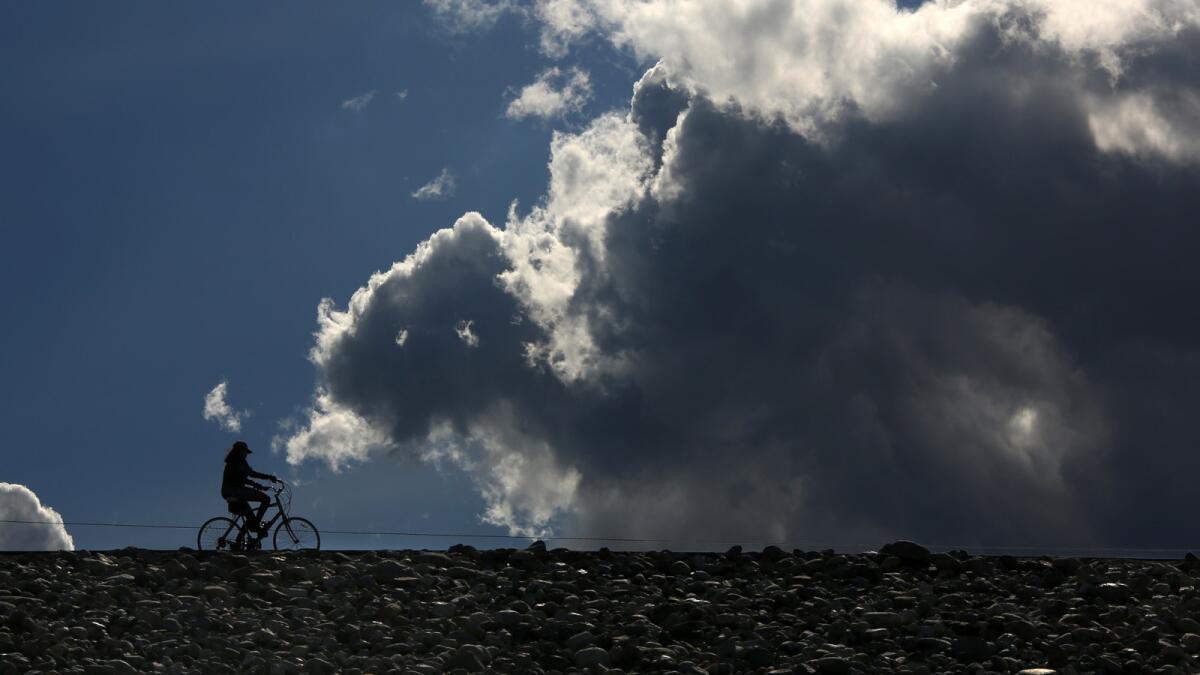Rising temps to bring dry end to Southern California’s poor rainy season

- Share via
Temperatures are expected to heat up toward the end of next week, signaling a dry, disappointing and foreboding end to the region’s rainy season as four years of low precipitation continue.
After several days of near-seasonal weather early in the week — with highs in the low- to mid-70s — the winds will turn offshore, allowing dry, hot conditions to press toward the coast and push temperatures to near-record levels, about 15 to 20 degrees above normal, forecasters said.
By Friday, the high will probably edge over 90 degrees in downtown Los Angeles, said David Sweet, a meteorologist with the National Weather Service in Oxnard.
“This is only March,” he said. “This is pretty early for temperatures up around 90.... We’re really running out of time when it comes to the rainy season.”
The rainiest months in Southern California are December through March. Since Oct. 1, downtown L.A. has recorded 7.4 inches. About 12.8 inches would be considered normal. The total in March has been a paltry .87 inches.
No relief is in sight, said Bill Patzert, a climatologist at the Jet Propulsion Laboratory.
“Let’s get right down to it: We’re done. By April, usually, rainfall drops off dramatically,” Patzert said. Just as importantly, the state’s snowpack, a source of runoff that fills reservoirs, has continued to shrink.
“Nothing got better this year,” Patzert said. Record-breaking warmth up and down the state “decimated the snowpack.”
The dry outlook spurred state officials to reach for a response. On Thursday, Gov. Jerry Brown and top lawmakers from both parties unveiled a plan that would spend more than $1 billion to improve the state’s water infrastructure, provide emergency assistance to struggling communities and protect wildlife.
“This is a struggle,” Brown said during a Capitol news conference. “Something we’re going to have to live with. For how long, we’re not sure.”
Most of the plan involves spending bond funds that voters already approved or paying money faster than previously scheduled. Some projects may not be completed for years.
Brown stopped short of calling for mandatory water rationing, although he declined to rule them out.
Also last week the state water board tightened restrictions, advising urban agencies to limit days residents can water their yards. The board also warned that it would impose tougher restrictions if local agencies don’t ramp up conservation.
“We are not seeing the level of stepping up and ringing the alarm bells that the situation warrants,” said Felicia Marcus, chairwoman of the Water Resources Control Board.
Responses at local levels have varied, according to the Assn. of California Water Agencies.
Long Beach allows landscape watering on Monday or Thursday. Restaurants serve water on request. Residents washing cars can’t leave a hose running while they soap their vehicles. And they can’t hose off paved surfaces.
L.A. allows outdoor watering three days a week, alternating between odd and even addresses.
Central Valley water districts have sharply reduced water allotments to farmers.
The big picture, said Patzert, is that an extended period of drought has waxed and waned since 2000—such droughts are part of a natural climate cycle. But effects from the current dry period are exacerbated by increased population and agriculture. Moreover, “this is the fourth year of extreme punishing drought.”
Future drought cycles are likely to be worsened by man-made climate change, he said.
Patzert said that he found the state’s response perplexingly “laid-back” and that current levels of water use are “unsustainable” in the long term.
Twitter: @howardblume
Sign up for Essential California
The most important California stories and recommendations in your inbox every morning.
You may occasionally receive promotional content from the Los Angeles Times.








